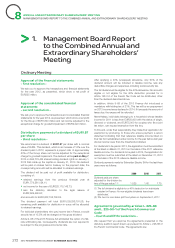APC 2012 Annual Report Download - page 276
Download and view the complete annual report
Please find page 276 of the 2012 APC annual report below. You can navigate through the pages in the report by either clicking on the pages listed below, or by using the keyword search tool below to find specific information within the annual report.
274 2012 REGISTRATION DOCUMENT SCHNEIDER ELECTRIC
ANNUAL AND EXTRAORDINARY SHAREHOLDERS’ MEETING
8MANAGEMENT BOARD REPORT TO THE COMBINED ANNUAL AND EXTRAORDINARY SHAREHOLDERS’ MEETING
The Supervisory Board of May 3, 2012, under the terms of the
regulated agreements, decided that the involuntary severance
pay explained in section 2 above will not be due if the dismissal or
resignation requested of Mr. Tricoire is motivated by serious or gross
misconduct according to the criteria adopted by jurisprudence.
The Management Board proposes to approve this amendment
to the status of Mr. Tricoire that reinforces the eligibility criteria
requirement for potential severance pay.
Appointment of a Supervisory Board member
- sixth resolution-
Please note that the term of Mr.Gérard de La Martinière expires at
the end of the Shareholders’ Meeting.
It is proposed to renew his appointment as member of the
Supervisory Board for a term of 2 years in accordance with
article11 of the articles of association. Mr.de La Martinière is an
independent member. Moreover, as Director or member of the
Supervisory Board of Schneider Electric SA for more than 12years,
his years of service are not considered to be a hindrance to his
independence due notably to his personality and involvement in the
work and discussions on the operation of the Audit Committees.
Share buybacks
- seventh resolution -
We request that you renew the authorization given to the Company
by the General Meeting of May3, 2012 to buy back its shares by
any appropriate method, including through the use of derivatives,
pursuant to the provisions of article L. 225-209 of the French
Commercial Code.
The Company buyback programs may have various objectives:
reducing the capital stock, covering stock option plans, allocating
shares to employees or corporate offi cers, fulfi lling obligations
related to convertible bonds, making acquisitions, and for market
making as part of a liquidity contract.
Shares bought back under this authorization may be canceled
(twentieth resolution) adopted by the current Shareholders’ Meeting.
Further information on your Company’s share buyback programs is
provided on page 258 .
You are asked to authorize the Company to buy back shares
representing at most 10% of the issued capital as of the date of
the Meeting (e.g., 55,541,701shares based on issued capital as
at December 31, 2012). The maximum purchase price is set at
EUR75. This authorization will not be available during public offer
periods.
Extrao rdinary Meeting
New organization of governance
- eighth resolution -
By the eighth resolution, you are asked to approve the new form of
the Company’s corporate governance.
The Supervisory Board proposes to change the organization of the
governance of the company to set up a Board of Directors and
combine the functions of Chairman and Chief Executive Offi cer.
If you approve this proposal, the Board will include current members
of the Supervisory Board as well as Jean-Pascal Tricoire, the current
Chairman of the Management Board, who will then become CEO.
This proposal continues the implementation of the succession
plan of Henri Lachmann. It is the culmination of over two years of
work and refl ection undertaken both within the Remunerations,
Appointments and Human Resources Committee as well as the
Supervisory Board and with which the Chairman of the Management
Board was involved.
It is proposed to return to the combined structure (Board of
Directors), which was the mode of governance of Schneider
Electric until 2006. The transition to a dual structure (Supervisory
Board/Management Board) has been successful in ensuring the
succession of the head of the Group’s Senior Management.
However, over the long term, this structure, which relies on two
bodies - a Supervisory Board and a Management Board, does not
appear entirely appropriate to the situation of Schneider Electric.
The French Commercial Code limits the maximum number of
members of the Management Board to seven and provides for the
collective operation of the Board.
This limit on the number of Management Board members is
incompatible with the managerial organization implemented by
Jean-Pascal Tricoire, which results in a managerial line of more than
ten managers in order to be closer to customers and employees.
In addition, to cope with the extreme volatility of the environment,
it should be extremely responsive. But this ability to respond is
hardly compatible with a cumbersome collective operation. These
constraints have so far been circumvented with the introduction
of a two Management Board members, but this solution is not
fundamentally good.
Moreover, practice has shown that the two levels of governance,
that of the Management Board to which the Executive Committee is
attached, and that of the Supervisory Board, do not facilitate close
working relationships between the members of the Supervisory
Board and the members of Executive Committee.
Returning to the Board of Directors format will guarantee that
the Group’s Senior Management is more responsive. In addition,
it will allow members of the Board of Directors to have a deeper
understanding of the business by more direct contact that they
will have with members of the Executive Committee and especially
that they will have more legal responsibility due to the change in
governance.
Beyond the adoption of a new mode of governance, it is intended
to combine the functions of Chairman and Chief Executive Offi cer
as is the practice of a vast majority of companies in the CAC40. It
brings clarity to the title of the person charged with managing the
Group, giving that person the title of Chairman. This clarifi cation is
particularly necessary vis-à-vis employees, customers and partners,
in France and abroad.
























